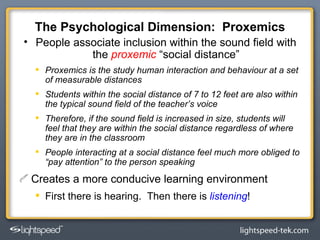Canadian light speed with proxemics
- 2. Equal Access to the Teacher°Øs Voice - Every Child - Every Word - Every Time Classroom Audio Technology
- 3. Lightspeed°Øs Guiding Purpose To improve the listening and learning environment of every child Lightspeed believes strengthening the connection between teachers and students is at the heart of learning
- 4. Classroom Audio Technology Defined: A speech intelligibility system that provides clarity of voice and even sound distribution throughout the classroom CAT helps to level the playing field, allowing every child an opportunity to clearly hear spoken instruction
- 5. Classroom Audio: A Three Decade Timeline 1980 1985 1990 1995 2000 2005 2009 Personal FM FM for all students 1st generation of IR 2nd generation of installed IR No-install IR FM soundfield for children with hearing loss
- 6. Classroom Audio Technology: Why? Basics of Physics, Speech, and Human Learning Voice level is reduced by 75% each time the distance from the teacher doubles - Hyper Physics (@ C.R.Nave, 2005) 90% of word recognition and comprehension is discerned from consonant sounds which, due to their high frequencies, are extremely difficult to project over distance relative to the lower frequency vowel sounds In order to deliver intelligible speech, high and low frequencies need to be °∞balanced°± for the particular acoustic space Auditory Closure ~ °∞Filling in the Gaps°± ~ Facilitates Auditory Processing Creates a more conducive learning environment Teacher can speak in a natural voice ~ Less Stress!
- 7. Classroom Audio Technology: Signal to Noise Ratio Source: Finitzo-Hieber & Tillman 1994 3 ft. 6 9 12 16 24 Distance in Feet from Teacher Normal Seating Region Teacher Voice Projection 70dB 64dB 58dB 56dB 52dB 90% 46% 10% Word Recognition Scores Avg. Room Ambient Noise 60dB
- 8. The Psychological Dimension: Proxemics People associate inclusion within the sound field with the proxemic °∞social distance°± Proxemics is the study human interaction and behaviour at a set of measurable distances Students within the social distance of 7 to 12 feet are also within the typical sound field of the teacher°Øs voice Therefore, if the sound field is increased in size, students will feel that they are within the social distance regardless of where they are in the classroom People interacting at a social distance feel much more obliged to °∞pay attention°± to the person speaking Creates a more conducive learning environment First there is hearing. Then there is listening !
- 9. The Psychological Dimension: Proxemics The °∞Social Distance°± of 4 to 12 feet is the typical effective sound field for a teacher°Øs voice
- 10. The Psychological Dimension: Proxemics Students within the Social Distance can hear clearly and feel obliged to listen
- 11. The Psychological Dimension: Proxemics Students who are farther away not only receive less auditory information, they feel less obliged to pay attention ~ double jeopardy! 3 ft. 6 9 12 16 24 Distance in Feet from Teacher Normal Seating Region Teacher Voice Projection 70dB 64dB 58dB 56dB 52dB 90% 46% 10% Word Recognition Scores Avg. Room Ambient Noise 60dB
- 12. ?
- 13. ?
- 14. Classroom Audio Technology: The Benefits Improved attention span Improved on-task behavior Increased academic achievement Reduced Classroom Management Reduced vocal strain & fatigue Reduced stress in classrooms Increased teaching efficiency Lower teacher absenteeism Narrow achievement gap Success for all students Reduced referrals to spec ed Teacher Student School Board Increased engagement
- 15. The Validated Results ®C Achievement Gains in Districts Studied 21% increase in developmental reading assessment scores (DRA) Chelius, Canby School District, OR, 2002 33% increase in number of students testing at or above grade level; with most growth from students in lowest quartile Boswell, West Orange, NJ, 2006 43% decrease in number of K-6 students being referred to special education Mainstream Amplification Resource Room Study, 2005 35% increase in reading fluency for 4 th & 5 th graders Chelius, Canby School District, OR, 2002 64% increase in speech intelligibility scores Brophy, Ayukawa, Univ. of Ottawa, ON, 2000
- 16. Examples of Validated Results ®C Teacher Attendance, Wellness, and Classroom Management in Districts Studied 43% reduction in off-task behavior & 72% reduction in teacher redirections Chelius, Canby School District, OR, 2002 25% decrease in overall teacher sick days taken in amplified classrooms Gertel & McCarty, Orange County Public Schools, FL, 2004 64% decrease in teacher sick days taken off due to voice related problems Allen, Dubuque Community School District, IO, 1996 89% decrease in teacher vocal fatigue & 86% decrease in overall stress Boswell, Baltimore County Public Schools, MD, 2006
- 17. Attendance Management: A Quick Calculation for a public school board in Western Ontario Assumption 1: $3.0 million/yr on TOC°Øs for elementary schools Assumption 2: ~ 17,000 elementary students/23.5 = ~723 classrooms Assumption 3: 723 classrooms x $1000 REDCAT = $723,000 Assumption 4: X% annual decrease in primary teacher sick days taken Projected Decrease in Sick Days Taken 8% 10% 12% Annual Cost Savings $240,000 $300,000 $360,000 Project Payback in Years 3.0 2.4 2.0
- 18. Classroom Audio Technology: How it Works Complete integration of the latest instructional technologies
- 19. Installation of equipment can be costly and require extensive preparation time and meetings Changing curriculum is expensive & time consuming Teachers change assignments, classes and schools frequently Most technology adaptations require significant training Training time is limited Professional training is continuously needed for all subjects With the newest generation of °∞All-in-One°± classroom audio systems: no installation, no change in curriculum, no lengthy teacher training required Adopting New Technology in the Classroom
- 20. Money-saving, no installation, all-in-one audio system Small, lightweight, easy-to-use microphone + Introducing°≠
- 21. All-in-one, no installation required Saves time : no more endless meetings around implementation Saves money: >30% cost savings compared to traditional sound systems Simple: easy to implement, easy to use More Technology for Less: put more systems into more classrooms Clear Audio, Excellent Sound Distribution: NXT Technology, high speech intelligibility Money-saving, no installation, all-in-one audio system
- 22. ?
- 23. Frequency Response and Crossover NXT Cone Crossover Point REDCAT Media °∞ Bass°± Speech Intelligibility Frequency in Hz Level in dB
- 25. Microphone Options Easy to use volume controls Pass around mic for students
- 26. Installed Classroom Audio Hub Options Three products in the family: CAT 805iX: Adds voice reinforcement to your existing audio system CAT 855: Audio Hub for the classroom CAT 885: Advanced features for media centers and larger classrooms
- 27. Installed System Speaker Options Ceiling vs. Wall Speakers Depends on classroom configuration Single Speaker vs. Multiple Speakers Installation cost savings MCQ Multimedia Ceiling Speaker (x1) NXQ Flat-panel wall speaker (x1) DRQ Ceiling Speaker (x4) WMQ Wall Speaker (x4)
- 28. New: MCQ Multi-Media Speaker Hybrid design combines NXT flat panel speaker with 6°± cone speaker Only one speaker is needed per classroom; reducing installation costs
- 29. iR Media Connector Wireless audio integration without installation Flexibility in location - locate media & REDCAT where it is convenient Integrate under-utilized multimedia to REDCAT
- 30. °∞ The more children hear°≠ the better they learn°± Any Questions?
Editor's Notes
- #3: Hearing is one of the primary channels for learning. It simply comes down to the fact that the more children hear, the better they learn. Regardless of the approach taken to raise academic achievement, classroom amplification offers is proven results without changing the curriculum or teaching methodology.
- #4: We know that up through grade three, children are listening to learn and more specifically, listening to learn to read. By fourth grade children are reading to learn. So classroom amplification is critical in pre-school through third grade as these children are developing the auditory ®Clinguistic foundation that is essential for success in the years that follow.
- #5: CAT helps to level the playing field, allowing every child an opportunity to clearly hear spoken instruction.
- #7: In order for learning to occur, children have to be able to hear and make sense of all of the spoken instruction. The loudest sounds in speech are low frequency vowel sounds and they are relatively easy to hear. On the other hand, 90% of the intelligibility of speech is conveyed by the consonants in the higher frequencies. Due to their higher frequencies, these soft consonant sounds are difficult, if not impossible to project loudly over the same distance as vowels. In order to deliver intelligible speech, we need to boost the softer sounds and reduce the energy in low frequency sounds a bit. We know that up through grade three children are listening to learn and more specifically, listening to learn to read . By fourth grade children are reading to learn. So classroom amplification is critical in pre-school through third grade as these children are developing the auditory ®Clinguistic foundation that is essential for success in the years that follow.
- #8: Note: °∞Here°Øs what we°Øve experienced in the US ®C specifically related to the ELL learning environment.°± This begins to introduce the environmental issue
- #9: Paying attention is a separate issue from being able to hear clearly. Keep in mind, hearing is NOT listening! All teachers know the value of closer proximity when paying attention is an issue for a student or students. Sound field systems create the sonic illusion of being closer to the person speaking than is actually the case. Psychologically, there is an almost irresistible urge to pay more attention to someone who is within the °∞social distance°± range, even if it is just the auditory sense of proximity.
- #10: Here is a graphic representation of how proxemic distances work. The blue circle indicates the °∞social distance°±. The green circle (12 to 25 ft. and beyond) represents the °∞public distance°±. Students farther away than 12 feet will not only be able to hear less clearly (especially in a high ambient noise environment) but they will be less inclined to pay attention due to the increased proxemic distance. Listening is °∞optional°± at public distances. At personal distances, most people are socialized to feel obligated to pay attention and listen to the person who is speaking.
- #11: A sound field system creates the auditory illusion that everyone in the room is within °∞personal distance°± of the teacher, even when they can see that they are farther away. Sound field systems essentially expand the perceived social distance.
- #18: 2007 School Board Spending (revised 2008 estimates): Peel total supply teacher cost: $9,597,000. From their budget docs on website, estimated 49,500 elementary students iin 08/09 school year. Calculation: 9.6m x .08 = $768,000, 9.6m x .10 = $960,000, 9.6m x .12 = $1,152,000 Calculation: 2,520,000 investment / $768,000 cost savings = project payback time






























